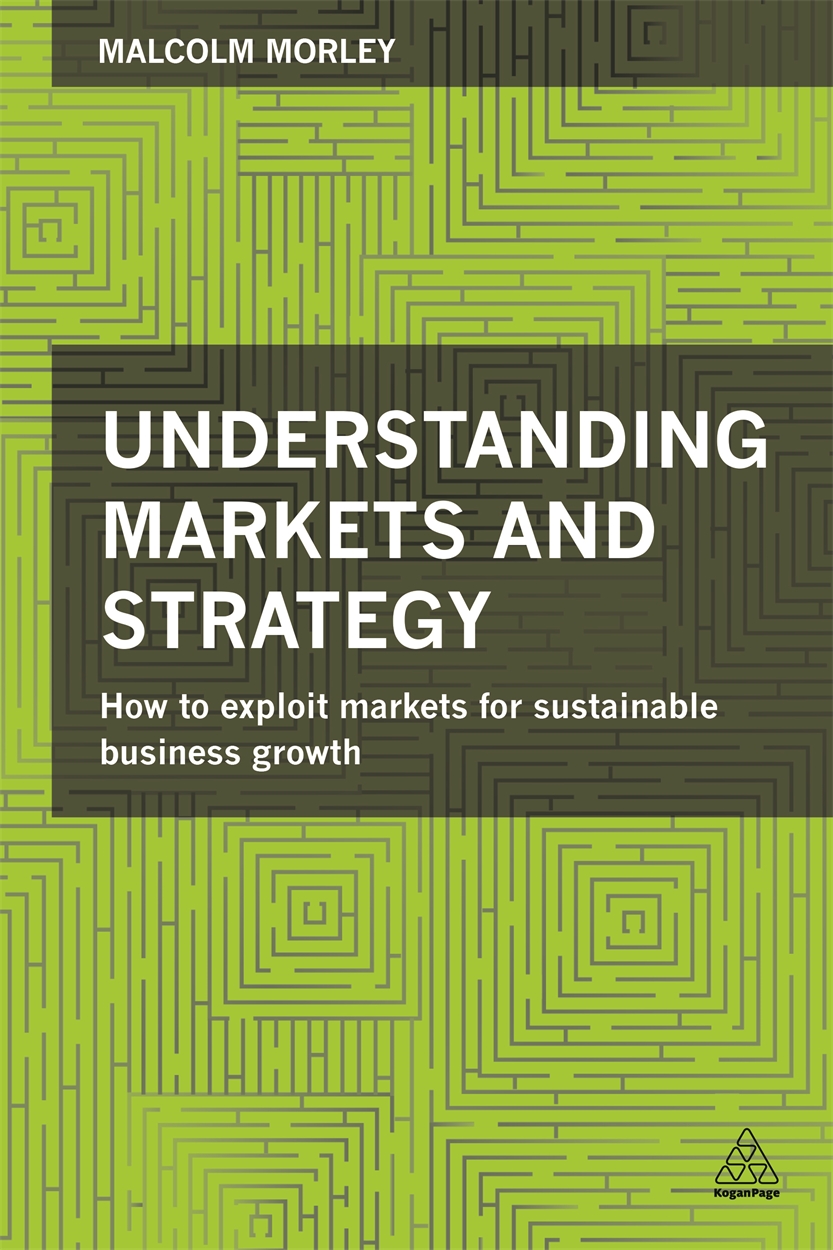Understanding Markets and Strategy: Advice from Malcolm Morley

How can you consider and develop competitive strategy if you don’t understand the markets you are competing in? Understanding Markets and Strategy author Malcolm Morley addresses this crucial issue from an original and practical standpoint.
 You have had experience in Board level roles in the private sector. What do you think managers can learn from your book?
You have had experience in Board level roles in the private sector. What do you think managers can learn from your book?
I worked with international and national companies and I was constantly surprised by how managers often had an internally focused view of their competitive market environment and how they developed strategies for their companies without a clear analysis and evaluation of the market now and how it might develop in the future.There was a disconnection between the external competitive market dynamic, and the emerging strategic issues within it, and the company’s competitive strategy. Opportunities were missed and the potential that the companies had were never fully exploited. Not understanding the market often meant that companies didn’t have an adequate supporting corporate strategy. This then led to investments in organisational competencies, capabilities and capacity that either constrained the company’s ability to change or left it having to play catch-up in response to the actions of competitors. My book provides a means for managers to take an external view of markets, competition within them and to understand the current and future strategic issues within them. It seeks to develop the strategic thinking of managers and to move them from forever being reactive to events to being proactive in the markets in which they seek to compete. Understanding Markets and Strategy provides a means for managers to identify and focus on what really matters and what they need to do to achieve their objectives for the market now and in the future.
When books are normally about either marketing or strategy, why have you chosen to address markets and strategy?
When researching the proposal for the book I found very few books on understanding markets whilst there were literally hundreds on marketing. In these books it was all about how to promote the company and its products. Markets were superficially defined but not explored in any depth. This prompted the question: How can you consider marketing if you don’t understand markets? Marketing has to relate to an external context and that external context is the market. It is buyers in markets that make the buy decision. It is buyers who evaluate competing products and services in the market. Similarly, competitive strategies relate to markets. When reviewing books on strategy, understanding markets was again not explored in any real depth. The books were generally about tools and techniques for strategic analysis and focused on competitors rather than buyers in markets. Again this prompted the question: How can you consider and develop competitive strategy if you don’t understand the markets within which you are to compete? Consider building a house. You need to build the foundations before you build the house above ground. Understanding the market is akin to the foundations. The strategy relates to the type of house that is built to meet the needs of buyers and how it can be built to make a profit relative to the competition in the market. Marketing is how you convince buyers to buy your house.
Your approach appears to undermine a rational approach to strategy: why?
People, and how they react to events, are unpredictable. Analysis and evaluation of markets and the development of strategy have to recognise how people identify and evaluate their contexts and events and how they are able/unable to change behaviours. Why is it, for example, that some supermarkets recognised changes in the market for groceries and how buyers want to buy them and consequently developed internet based shopping channels to market much earlier than others who are struggling as a result? Understanding Markets and Strategy explores how buyers in markets convert data into information, how they use that information to make the buy decision and how they evaluate competing products and services. In this way strategic market issues and strategic organisational issues can be identified both now and for the future. This understanding enables companies to develop scenarios and strategies for the future. In doing so there is recognition that strategy is not a science but an art; the art of understanding people and their impact on markets. This means that managers need to be able to make assumptions about market developments, about competition and about their own organisations. They have to recognise that cause and effect is often a complex relationship and they have to put their organisations in a position to flex their strategies. Understanding Markets and Strategy provides practical tools and techniques for the strategy process to be brought to life within organisations and kept relevant to the changing markets within which they operate. It recognises that strategy often does not conform to rationality and that the strategy process has to be realistic or become merely a promotional brochure risking strategic drifting and disconnection from the market.
Do you think that managers are willing and able to change their own perceptions of markets and strategy, and those of their colleagues?
Change is a means to an end. Managers need to determine what that end is and then be able to put their organisations and their competitors in that context. This strategic thinking is, regrettably, not something that professional training or operational experience prepares managers for in their career development. In many organisations career progression is based upon being a long serving and/or good professional/operational manager. This means that many managers find it difficult to achieve this paradigm shift. Understanding Markets and Strategy helps managers to recognise and to navigate this paradigm shift. It also recognises that a paradigm shift journey is best taken together with others rather than in isolation. To this end it provides practical exercises that can generate shared understanding and commitment to new ways of thinking and working.
Given today’s uncertain world, how can companies improve their strategies to achieve sustainable business growth?
There isn’t a prescription for success but there is a certainty that if companies don’t meet the needs of buyers they will not be able to compete. Sustainable business growth requires an ongoing understanding of markets, the recognition of changes within markets and the development of competitive and corporate strategies that enable companies to both respond to those changes and to influence them. Key elements of this are the development of scenarios and ensuring the currency of the company’s competencies, capabilities and capacity.Understanding Markets and Strategy explains, and provides tools and techniques for, the development of scenarios. Most importantly it enables managers to evaluate their company’s products and services within a strategic market context to ensure that they are not only competing now but preparing for competing in the future.
What are the roles of leaders and managers in achieving sustainable business growth?
Managers ensure that things are done right whilst leaders ensure that the right things are done.So too with sustainable business growth. Managers deliver the strategy whilst leaders, through their strategic thinking, develop the strategy. Of course the boundaries between leading and managing are often blurred, and the development of strategy should be inclusive, but without leadership companies would find it hard to achieve sustainable business growth. Leaders have to have the ability to challenge and to change their organisations and their strategies. They have to ensure that they are not constrained by the past and the present. They have to be able to think strategically for the future.As markets are about people so too is leadership and managing. Too frequently companies are constrained by their histories and past decisions drive choices for the future. Managers will drive their companies to be better at what they are doing now and have done in the past. Leaders will recognise when it is necessary to change and then drive that change. Understanding Markets and Strategy helps managers develop into leaders and helps leaders to recognise how to fulfil their roles.
The tools and techniques introduced in your book constantly refer to the need to jointly identify assumptions about markets; why is this necessary?
Whilst one person may be a prophet in a company it takes many people to make a company successful. It is also often the case that people in companies have a dominant collective logic about the value of their products and services, about their ability to compete and about how markets will develop in the future. Strategic change often requires challenging the dominant collective logic within companies. If only one person, a prophet, is proposing change against the dominant collective logic there is a danger that they will be treated like a heretic. A critical mass of understanding and opinion has to be gathered to make change a reality and to ensure that it is embedded within organisations. Understanding Markets and Strategy recognises this reality and provides tools and techniques to gather the critical mass of understanding, opinion and support necessary to achieve change. In this way the strategic competencies within the company can be improved and the potential created for strategic and organisational cultural change can be realised.
Developing a company’s strategic competencies requires a shared ongoing approach to understanding markets and how the strategies for them are performing; what are the keys to make this happen?
Companies frequently focus on operational or professional competencies rather than the strategic competencies required for sustainable business growth. This is often a reflection of the focus on management rather than leadership. Managers that have been sent on strategic management courses or MBAs become frustrated upon returning to their companies because they do not have the opportunity to apply the knowledge that they’ve gained. They leave, and the companies do not get a return on their investment. In many companies silos still exist where the competencies are focused on the silo and not on the achievement of the company as a whole. Opportunities are missed because performance management and accountability relate to the silo and not to the whole company.The development of a company’s strategic competencies is an important challenge for all leaders. Market and competitor intelligence needs to be shared throughout the company and inform the competitive strategy process. In this way the company can understand the market, how its strategy is performing and what it needs to do to achieve sustainable business growth. Just relying on monthly sales figures is not enough.
Many companies believe that they are either in the business of products or services, but you present them as being indivisible from each other. Why is this the case?
No product exists without a service to support it. Companies can have great products but if the services associated with them are poor the buyer’s perception of the product will be negatively affected. This is particularly important as companies often invest heavily in product development but not sufficiently in the services that support them. As companies fragment their value chains and value systems they increasingly rely upon third parties to provide services to support their products. They are putting the reputation and competitive strategies in the hands of those third parties.We all know that customers contacting a call centre and getting a bad experience, for example, will both tell many others and be more likely to change their supplier. The company is perceived to be only as good as the customer interface services provided.In this competitive environment, increasingly demanding flexibility of supply and seamless service, few companies will fulfil their potential for sustainable business growth unless they recognise and act upon the relationship between products and services.
What is the relationship between sustainable business growth and access to strategic competencies, organisational capabilities and capacity?
The complexities of markets and competition are inexorably increasing. With complexity goes risk. If companies do not gain access to the necessary strategic competencies, capabilities and capacity to develop as organisations and as the basis for their ability to compete they increase their risk of failure.The nature, extent and level of the competencies, capabilities and capacity will vary with the changing demands of the market and the competition. They will change over time and companies need to be able to access them in different ways to achieve this access. Understanding Markets and Strategy explains fully what strategic competencies, organisational capabilities and capacity are and how they fit into the market and company contexts. It provides managers with details of how they can develop and/or gain access to those competencies, capabilities and capacity.
Understanding Markets and Strategy is available at 20% off with no charge for UK shipping. Just use the code UMS201 at www.koganpage.com.


